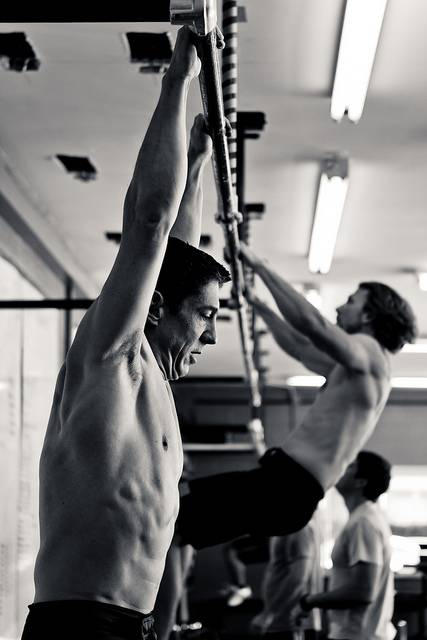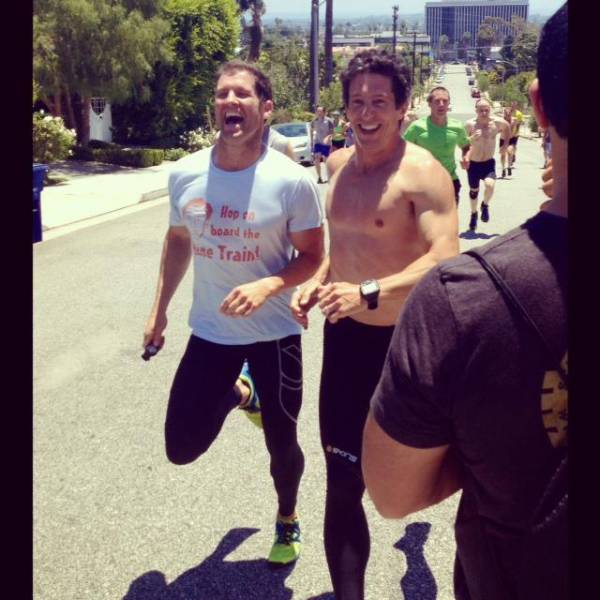You’re 35 years old, athletic, and play some recreation sports. You’re married (or thinking about it) and maybe have a kid or two. You work. A lot. You’re working to get ahead to pay for the things you want to enjoy in life. You don’t have much (if any) free time.
So, how do you train to keep yourself healthy, fit, and injury free? What is the right balance of intensity, endurance, weights, and recovery to ensure that you’re continuing to progress ten, twenty, even thirty years from now? What can you do for fewer than six hours each week to ensure you’re prepared for the rigors of life?
Those were the questions I started to ask myself about four years ago. Five years into my life as a CrossFit coach.
My Injuries Were Adding Up
One of the reasons I started to ask was because I was noticing myself getting injured. Not big, hairy, nasty crazy injuries, just little nagging things that wouldn’t go away for six months – or two years. Medial and lateral epicondylitis (tennis and golfer’s elbow); shoulder and hip joint pain; a heel stress fracture; wrist, thumb and big toe joint issues; random neck tweaks; and a recurring lower back tweak that would happen about twice a year after a deadlift workout. But were these really injuries? And was this style of training, along with the injuries, aches, and pain I was experiencing, really necessary for an elite and appropriate level of fitness? Could I get the results I wanted any other way?
My aches and pains, in hindsight, were definitely injuries. After all, they were preventing me from moving and performing at the level that I knew myself capable, and from feeling good in my normal, daily life. They came about as a result of my mindset and context, developed over the first five years of CrossFitting – training hard five to six days per week, and going AHAP (as hard as possible) every single workout. This is how I went from novice CrossFitter in 2004 to an individual qualifier (and participant in) the 2009 CrossFit Games.
I was fortunate that this worked for me. As a former professional endurance athlete and trainer with many years of experience, biomechanics, and anatomy under my belt (before starting CrossFit), I quickly mastered the mechanics of the CrossFit movements. This wasn’t to say that I could do them all with mastery (I’m still working on that – especially the snatch), but I knew what I was supposed to do and I had the body awareness to know, most of the time, when my form was off. I also knew from years as an athlete when to scale back in weight and when to really go for it. These skills kept me healthy at first, even though I was regularly driving myself into the ground during shorter duration, high intensity workouts.
It worked. Perfectly. For about five years.
Considering a Different Approach to CrossFit
But then those these little nagging issues started to creep in. “Non-injuries” as I’d like to call them. The first one was lateral epicondylitis (tennis elbow). I first experienced it when traveling and visiting CrossFit Ocean City, on the Maryland Eastern Shore. I remember it because on the drive back to Washington, DC, I had this strange pain in my right elbow when turning the steering wheel of the car that I couldn’t get to go away. That little pain led to about eight months of elbow rest – no pull ups, no Olympic lifts, rowing without bending the elbows, and hundreds of dollars (maybe thousands) on physical therapy. Eight months later the pain was gone. Then, suddenly, out of the blue – golfer’s elbow.
 It went like that, one little nagging issue at a time, scattered all over my body, each seemingly unrelated to the other, for a couple years. Until I started to actually look at things. Maybe a different version of the CrossFit Kool-Aid was something to consider? A version that allowed me to enjoy a body and a life free of injury for many, many years to come. Maybe slamming myself against the wall as hard as I could day in and day out, putting in a maximal effort in every workout, while “fun” (in a CrossFit sort of way), wasn’t something that was sustainable for my body in the long run.
It went like that, one little nagging issue at a time, scattered all over my body, each seemingly unrelated to the other, for a couple years. Until I started to actually look at things. Maybe a different version of the CrossFit Kool-Aid was something to consider? A version that allowed me to enjoy a body and a life free of injury for many, many years to come. Maybe slamming myself against the wall as hard as I could day in and day out, putting in a maximal effort in every workout, while “fun” (in a CrossFit sort of way), wasn’t something that was sustainable for my body in the long run.
I started backing off in workouts. I got in the pool. I started doing recovery runs that were not for time. I also started to put less pressure on myself to compare what I was doing to other people. Time, weight, rounds, distance, and that all-important label of “Rx” all became lower priority. What became more of a priority was being aware of how my body felt before, during, and after a workout – and what I would do to be kind to it, take care of it, and allow it to heal and recover.
I sprinkled fast, intense workouts in when it felt right, and when I felt good, fresh and ready. During those workouts, I kept my focus inward – on me – and not outside of me, on the rest of the athletes in the room and on the whiteboard. And I never took my training too seriously. After all, a workout is just a workout. There are many other things that lead to fitness and health in life.
Still Doing CrossFit and Injury Free
I’ve been injury-free now for about a year. I still have a few minor and occasional pains, but all of the things that made me feel like my body was aging way faster than my athletic ability (feeling like “an old man”) are gone. I don’t feel creaky in the morning. I’m spending much more time mobilizing and stretching. I’m totally relaxed during workouts, literally dancing between sets and rounds (and I’m not a very good dancer – ask anyone who’s seen me) in order to physically remind myself to relax, be easy on myself, and have fun.
I’m doing two, maybe three CrossFit workouts a week and at least one strength workout (not for time) each week. If I’m feeling great, I go for it – and that is fun too! But I’m always thinking of the adage, “Live to fight another day.”
I’m doing some sprinting work once per week, and I’ve added in recovery endurance. This is different from the endurance I was doing before. Now, I’m intentionally keeping my heart rate down (yes, I’m even using a heart rate monitor), going at a pace that allows me to feel good and even carry on a conversation. I’m using these workouts as easy metabolic recovery and a way to build my endurance. I also love to work on technique during these workouts. Since I’m going easy, I have the brain capacity to actually think about what I’m doing, where I’m landing, and how I’m breathing. Sometimes I even stop mid run, ride, swim or row to reset my focus.
 The result of all of these changes has been a much happier me. I’ve been able to maintain most of the fitness I had before, I’ve actually improved my endurance, and my body is feeling more flow, energy, and life in it than it has in years.
The result of all of these changes has been a much happier me. I’ve been able to maintain most of the fitness I had before, I’ve actually improved my endurance, and my body is feeling more flow, energy, and life in it than it has in years.
As I get older, taking care of the temple that is my body becomes more and more important. This was the reason for writing my book, Fire Your Gym – to create a methodology and program that is doable and sustainable for years and years, taking advantage of the benefits of high intensity exercise, while sprinkling in the appropriate amount of recovery, endurance, and sprints. In our book, Roy Wallack (my writing partner and long time hard-core endurance junkie) progress people through strength, power, stamina, and endurance training and givs readers a template to follow for training for the rest of their lives.
I love how I feel as a result of this huge change in my life. I love the benefits from high intensity exercise and CrossFit, and I love how well it works when combined with other easier, slower, less intense training and recovery. I now have an incredibly high level of fitness that I can sustain for years to come, and a training program that supports my body, keeps me from getting injured, and allows me to be at my best each and every day.
Have you had to change your training as you’ve gotten older? What have you done that has worked for you? Post your thoughts to the comments below.
Photos provided by CrossFit LA.






